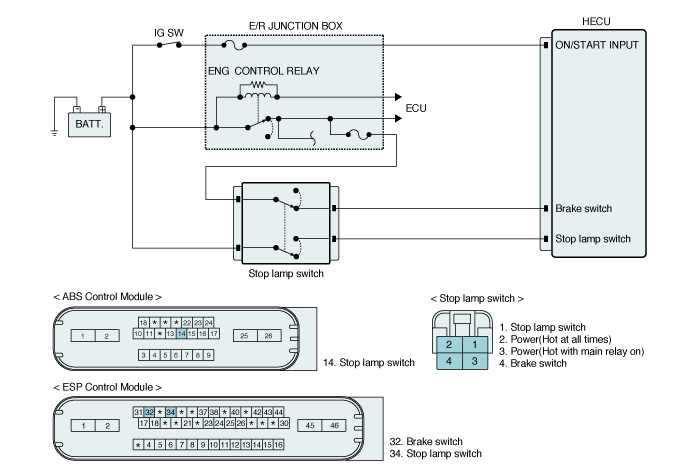Monitor the "BRAKE SWITCH" parameter on the scantool.
Specification : It is changed to ON/OFF.

Fig 1) Test Condition : Ignition "ON" & Engine "OFF"
Normal Data
This switch is mounted on the pedal assembly and is used to indicate brake pedal status to the HECU.
The switch is turned on when brake is pressed.
The brake light switch is a normally-open contact which runs to battery voltage when active (brake pressed).
When passive (brake released), the cable is grounded via the brake light bulbs.
The brake light signal is a reference to judge driver's intention for braking.
The HECU checks open or short circuit of brake light switch for normal ESP control.
If an error is present, the warning lamp will illuminate.
Item | Detecting Condition | Possible cause |
DTC Strategy | ● Open circuit monitoring | ● Open circuit in brake switch line ● Faulty brake light switch ● Faulty input stage in HECU |
Enable Conditions | ● If both BLS(brake lamp switch) and BS (brake switch) have a same state and MCP (Master Cylinder Pressure) >20bar for 500ms. ● Outside an ABS/ESP control, and after normal operation of MCP, If the pressure sensor signal is higher than 20bar and BLS is low for 3sec. ● If the BLS/BS changed more than 40times and MCP> 20bar for 5sec. ● While Vehicle speed > 10km/h, TPS>5%, MCP<7bar, if BLS is high over 1min. | |
Fail Safe | ● Inhibit the ESP control and allow the ABS/EBD control. ● The ESP warning lamp is activated. |
Brake Light Switch | Voltage Range of "High" | Voltage Range of "Low" |
7.0V ~ 16.0V | 0V ~ 3.0V |

Connect scantool to Data Link Connector(DLC)
Ignition "ON" & Engine "OFF".
Press the brake pedal.
Monitor the "BRAKE SWITCH" parameter on the scantool.
Specification : It is changed to ON/OFF.

Fig 1) Test Condition : Ignition "ON" & Engine "OFF"
Normal Data
Whenever brake pedal is pushed down, is the brake switch's scantool data changed ON/OFF?
 | ▶ Fault is intermittent caused by poor connection in brake light switch harness and/or HECU's connector or was repaired and HECU memory was not cleared. Thoroughly check connectors for looseness, poor connection, bending, corrosion, contamination, deterioration, or damage. Repair or replace as necessary and then go to "Verification of Vehicle Repair" procedure. |
 | ▶ Go to "Terminal and Connector Inspection" procedure. |
Many malfunctions in the electrical system are caused by poor harness(es) and terminal condition. Faults can also be caused by interference from other electrical systems, and mechanical or chemical damage.
Thoroughly check connectors for looseness, poor connection, bending, corrosion, contamination, deterioration, or damage.
Has a problem been found?
 | ▶ Repair as necessary and then go to "Verification of Vehicle Repair" procedure. |
 | ▶ Go to "Signal Circuit Inspection (brake pedal isn't depressed)" procedure. |
Signal circuit inspection (brake pedal isn't pressed)
Ignition "ON" & Engine "OFF".
Measure voltage between stop lamp switch (brake switch) terminal of the HECU harness connector and hassis ground.
Specification : Stop lamp switch - 0V
Brake switch B - B+
Is the measured waveform within specifications?
 | ▶ Go to "Signal Circuit Inspection (brake pedal is depressed)" procedure. |
 | ▶ Check for open or blown f use referring to "Circuit Diagram". Repair open or short in power circuit between battery and HECU harness connector and then, go to "Verification of vehicle Repair" procedure. If there is no problem in circuit, Go to "Component Inspection" procedure. |
Signal Circuit Inspection (brake pedal is pressed)
Ignition "ON" & Engine "OFF".
Press the brake pedal.
Measure voltage between stop lamp switch (brake switch) terminal of the HECU harness connector and chassis ground.
Specification : Stop lamp switch - B+
Brake switch B - 0 V
Is the measured waveform within specifications?
 | ▶ Fault is intermittent caused by poor connection in brake light switch harness and/or HECU's connector. Go to "Verification of Vehicle Repair" procedure. |
 | ▶ Check for open or blown fuse referring to "Circuit Diagram". Repair open or short in power circuit between battery and HECU harness connector and then go to "Verification of vehicle Repair" procedure. If there is no problem in circuit, Go to "Component Inspection" procedure. |
Ignition "OFF" & Engine "OFF".
Disconnect the stop lamp switch connector.
Measure resistance between power terminal and siganl terminal of the stop lamp switch connector.
Specification :
Resistance between terminals of the stop lamp switch - ∞Ω (when the plunger is pushed down), 0Ω (when the plunger isn't pushed down).
Resistance between the terminals of the brake switch - ∞Ω (when the plunger is not pushed down), 0Ω (when the plunger is pushed down).
Is the measured value within specifications?
 | ▶ Fault is intermittent caused by poor connection in brake light switch harness and/or HECU's connector. Go to "Verification of Vehicle Repair" procedure. |
 | ▶ Substitute with a known-good brake light switch and check for proper operation. If problem is corrected, replace brake light switch and then go to "Verification of Vehicle Repair" procedure. |
After a repair, it is essential to verify that the fault has been corrected.
Connect scantool and select "Diagnostic Trouble Codes(DTCs)" mode
Using a scantool, Clear DTC.
Operate the vehicle within DTC Detecting Condition in General Information.
Using a scantool, Check DTC present.
Are any DTCs present ?
 | ▶ Go to the applicable troubleshooting procedure. |
 | ▶ System performing to specification at this time. |